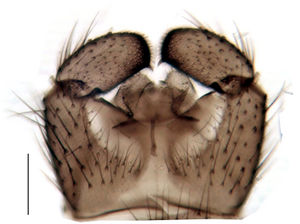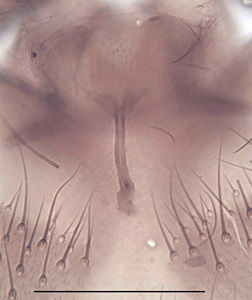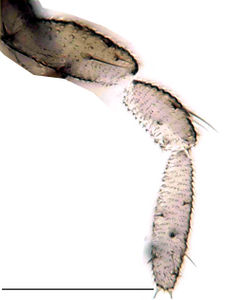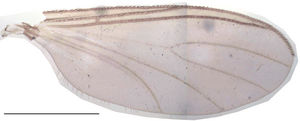Trichosiopsis cerifera
Ordo: Diptera
Familia: Sciaridae
Genus: Trichosiopsis
Name
Trichosiopsis cerifera (Mohrig & Menzel, 1997) – Wikispecies link – ZooBank link
- Leptosciarella (Leptosciarella) cerifera Mohrig & Menzel, 1997[1]: 70-71; fig. 18
Type material
Holotype: ♂, in PWMP, leg. Jaschhof, 19.09.1992
Type locality
Germany, Mecklenburg-Vorpommern, Rügen, Binz, beech forest
Material studied
Germany: 1 ♂, Baden-Württemberg, Blaubeuren, Tiefental, gorge forest, Malaise trap, Sipple, 28.8.-04.09.2008, PRSB 93; 1 ♂, 4.-11.09.2008, PRSB 121; 1 ♂, 7.-28.08.2008, PRSB 61; 3 ♂, Mecklenburg-Vorpommern, Greifswald, deciduous forest, Malaise trap, Jaschhof, 1994, PKHH 5299, 5307-5308, 5312-5313; 1 ♂, Schleswig-Holstein, Kiel University, garden, Malaise trap, Heller, 22.-29.09.1995, PKHH 1215; 1 ♂, Raisdorf, Klosterforst Preetz, beech forest, sweep netting, Heller, 06.09.2008, PKHH 6588; 1 ♂ 1 ♀, Trent near Plön, Trent bog, Malaise trap, Kassebeer, 11.-18.09.1993, PKHH 674; Sweden: 2 ♂, Ångermanland, Skuleskogen National Park, Langra: brook ravine in mixed forest, Malaise trap, Swedish Malaise Trap Project, 9.-23.08.2004, NHRS 4768, 4769; 6 ♂, NHRS 3872, 3876, 4432-4435; 2 ♂, 23.8.-24.09.2004, PKHH 7268; 2 ♂, Bohuslän, Ödsmal, Hällsberget, broad leaved deciduous forest, Malaise trap, Swedish Malaise Trap Project, 30.7.-11.08.2004, PKHH 5802, NHRS 941; 1 ♂, Gotland, Roleks, border between wood and open pasture; grazed calareous pine forest, Malaise trap, Swedish Malaise Trap Project, 2.-19.08.2004, PKHH 6846; 1 ♂, Skåne, Skäralid, valley below northern Lierna; rich beech forest, Malaise trap, Swedish Malaise Trap Project, 14.7.-06.08.2004, PKHH 6733; 1 ♂, Småland, Bäckebo, Grytsjöns naurreservat, Old moisty haymaking meadow in forest edge, Malaise trap, Swedish Malaise Trap Project, 13.-24.08.2005, NHRS 1094; 1 ♂, Alsterbro, mixed forest, Malaise trap, Swedish Malaise Trap Project, 25.-30.08.2005, PKHH 6820; 1 ♂, Stenbrohult, Kronobergs län, Djäknabygds bobacke, heath with old beeches, Malaise trap, Swedish Malaise Trap Project, 22.7.-25.09.2004, PKHH 7304; 3 ♂, Södermannland, Södertälje, Tullgarns näs, Rävsalaviken, mixed forest next to pasture, Malaise trap, Swedish Malaise Trap Project, 3.7.-19.08.2004, PKHH 7476, NHRS 4602, 4603; 1 ♂, Uppland, Lövstabruk, Malaise trap, Hippa & Gustafsson &, 19.-23.06.1992, NHRS 165.
Description (male)
Head. Eye bridge 4–5 rows of facets. LW-index of 4th antennal flagellar segment 3–3.4; neck 0.4–0.52 of segment width; Transition of basal part to neck pronounced. Colour of neck unicolour. Antennal hairs as long as segment width, or longer than segment width; sparse; salient. Palps darkened; normal; palpomeres 3. First palpomere of normal shape; with 3–6 bristles; with only some sparse sensillae. Second palpomere shortly oval. Third palpomere as long as first segment, or longer than first segment. Thorax. Colour reddish. Notum unicolorous. Thoracic setae normal; dark. Mesonotum with some weaker central bristles. Posterior pronotum setose. Postpronotal setae 4–5; fine. Laterotergite bare. Legs. Colour yellow. Hind coxae of same colour as femora. Hairs on fore coxae black, or darkened. Front tibia apically with a patch of setae. Front tibial organ dark. Front tibial organ not bordered. Tibial setae on hind legs weak, inconspicuous. Tibial spurs of equal length. Claws untoothed. Wings. Wings slightly darkened; of normal shape. Wing membrane without macrotrichia. Wing venation weak, with faint m-base. M-fork of normal shape. R1 inserting at or slightly before base of m-fork; posterior veins with macrotrichia; stM mainly with macrotrichia, or with a few macrotrichia; cuA1 and cuA2 mainly with macrotrichia; bM bare; r-m with a few setae, or mostly setose; bM:r-M 0.7–0.9; st-Cu:bM 0.35–0.5; r1:r 1.3–1.6; C:w 0.7–0.8. Halteres dark; of normal length. Abdomen. Abdominal setae strong and dense; dorsally dark; ventrally dark. Hypopygium concolour with abdomen; 0.56–0.7 × longer than wide. Base of gonocoxites with normal, weak hairs, or with strong setae; gonocoxites broadly separated; inner margin of gonocoxites normally U-shaped; inner part of hypopygium scarcely setose; elongated setae on valves of hypopygium absent. Gonostylus elongate; 1.8–2.1 × longer than wide; Inner margin straight; apex equally rounded, or with one obtuse angle. Apical tooth present; 2.05–2.4 × longer than broad; weak. Awl-like setae normal; below apex present. Megasetae on inner part of gonostylus absent. Whiplash-hair absent. Tegmen 0.55–0.75 × longer than broad; rectangular with rounded edges; normal; Central process absent. Length of aedeagus/hypopygium 21–35 %; Aeadeagal apical structure present. Measurements. Body size 3–3.6 mm. Hind tibia 1.65–1.77 mm. Wing length 2.8–3.3 mm.
Diagnosis
Trichosiopsis cerifera is characterized by the very long antennae and the parallel, but rounded gonostylus. It may be confused with Trichosiopsis scutellata, which has shorter antennae, a still more rectangular gonostylus and stronger setae at the hypopygial base. Trichosiopsis viatica and Trichosiopsis dimera are also closely related, but both species have more rounded gonostyli and Tr. dimera has shorter palpi and Tr. viatica shorter antennae and bright halteres. By the shape of the gonostyles Tr. cerifera is an intermediate form between the viatica and the scutellata species groups.
DNA Barcoding
COI sequences are assigned to the following BINs:
- BOLD:ACM3570 (average distance 0.59%, max. 2.09%, n=15, K2P: 1.45%)
- BOLD:ACR0606 (average distance 0.38%, max. 0.76%, n=4, K2P: 1.45%)
- BOLD:ACZ9444 (average distance 0.33%, max. 0.33%, n=2, K2P: 2.87%)
Discussion
Trichosiopsis cerifera is widespread in Europe and consists of three different genetic variants with K2P distance of less than 3% each. These are currently not regarded as different taxa, because the maximum intraspecific distance of the most common BIN BOLD:ACM3570 is higher than the distance to the nearest neighbour BOLD:ACR0606. Also, no morphological differences could be found for the members of the three genetic clusters.
Etymology
cera lat. = wax. No explanation was given.
Ecology
Trichosiopsis cerifera is not very common and was only reported from Central and Northern Europe. Until now it was not reared from dead wood, but was mostly found in deciduous forests and urban habitats.
Distribution
Czech Republic[2], Germany[1][3][4][5], Great Britain[6][7], Ireland[6][7], Norway[8], Sweden[9].
Images
|
References
- ↑ 1.0 1.1 Mohrig, W.; Menzel, F. 1997: Revision der paläarktischen Arten von Trichosia Winnertz sensu Tuomikoski, 1960 (Diptera, Sciaridae). – Teil II. Gattungen Leptosciarella Tuomikoski, 1960 und Trichodapus gen. nov. Studia dipterologica, 4(1), 41–98.
- ↑ Rudzinski, H.-G. 1998: Sciaridae. In: R. Rozkošný & J. Vaňhara (Eds.), Diptera of the Pálava Biosphere Reserve of UNESCO, I, Folia Facultatis Scientiarium Naturalium Universitatis Masarykianae Brunensis, Biologia. Brno. pp. 49–55.
- ↑ Hennicke, S.; Martschei, T.; Müller-Motzfeld, G. 1997: Erste Ergebnisse der Erfassung ausgewählter Arthropodengruppen der Stadt Greifswald (Araneae, Coleoptera, Diptera, Hymenoptera, Saltatoria). Insecta, 5, 51-100.
- ↑ Menzel, F.; Schulz, U.; Taeger, T. 2003: Neue Trauermücken-Funde aus dem nordostdeutschen Tiefland, mit einer ökologischen Betrachtung von Wurzelteller-Fängen und einer Checkliste der aus Berlin/Brandenburg bekannten Arten (Diptera: Sciaridae). Beiträge zur Entomologie, 53(1), 71–105.
- ↑ Heller, K. 2004: Eine Bestandsaufnahme der Sciaridae (Diptera) Schleswig-Holsteins mit Ergänzungen und Korrekturen zum bisher bekannten Arteninventar. Faunistisch-Ökologische Mitteilungen, 8, 233–257.
- ↑ 6.0 6.1 Chandler, P.; O’Connor, J.P.; Nash, R.; Withers, P. 2002: Diptera new to Ireland in seventeen families. Dipterists Digest (Second Series), 9(2), 121–136.
- ↑ 7.0 7.1 Menzel, F.; Smith, J.E.; Chandler, P. 2006: The sciarid fauna of the British Isles (Diptera: Sciaridae), including descriptions of six new species. Zoological Journal of the Linnean Society, 146, 1-147. PDF
- ↑ GBIF Trichosiopsis cerifera
- ↑ Heller, K.; Vilkamaa, P.; Hippa, H. 2009: An annotated check list of Swedish black fungus gnats (Diptera, Sciaridae). Sahlbergia, 15(1), 23-51.






